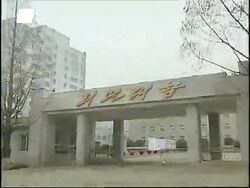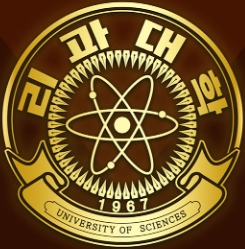University of Sciences
Topic: Organization
 From HandWiki - Reading time: 4 min
From HandWiki - Reading time: 4 min
리과대학 | |
 | |
| Type | Public |
|---|---|
| Established | 1967 |
| President | Kim, Jun-Nam [1] |
| Students | 3000 |
| Location | Eunjeong-guyok, Science 1-dong, Pyongyang , North Korea |
| Campus | Urban |
 | |
| University of Sciences | |
| Chosŏn'gŭl | 리과대학 |
|---|---|
| Hancha | 理科大學 |
| Revised Romanization | Script error: The function "transl" does not exist. |
| McCune–Reischauer | Script error: The function "transl" does not exist. |
University of Sciences is a university located inside the region of the National Academy of Science in Pyongyang, North Korea. The university was previously called as "Institute of Natural Science".[2] UOS is geographically located in Pyongsong, South Pyong'an Province, North Korea. However, North Korean government appointed the area of science district to belong to Pyongyang for giving some privileges of Pyongyang citizens to scientists of NAS and students of UOS. As Kim Il Sung, a former leader of North Korea, emphasized the significance of education for gifted and talented students, UOS originally started as a branch of Kim Il Sung University on January 17, 1962. It was separated from Kim Il Sung University in 1985. In North Korea, this university is known as "Sujae Daehark (University for talented students)".[3] In South Korean mass media, this university is called "KAIST of North Korea".[4]
Top students of natural sciences or engineering in North Korea study at this university supported totally by North Korean government. Eighty percent of them is graduated from No.1 Middle Schools, which are science high schools for gifted and talented students in North Korea, and the rest twenty percent are medal winners in the National Science Olympiads (math, physics, chemistry, and biology) or national science quiz contests.[5] Unlike other universities in North Korea, students entering UNS have age limit. Equal or younger than 17 people are eligible to take entrance exam for UOS.[6]
It is known that many alums of this university are involved in projects for developing missiles and launching artificial earth satellites.[7]
Departments
There are six departments in UOS. Each department has five or six majors.[citation needed]
Physics
- Theoretical Physics
- Thermal Physics
- Solid State Physics
- Optics
Mathematics
- Control Mathematics
- Applied Mathematics
- Information Mathematics
Chemistry
- Theoretical Chemistry
- Inorganic Chemistry(material)
- Organic Chemistry
- Analytical Chemistry
- Laboratory of Applied Chemistry
Biology
- Molecular Biology
- Chemical Biology
- General Genetics
- Molecular Genetics
- Cell Genetics
- Statistical Genetics
- Biological Information
Computer Engineering
Electrical Engineering
Mechanical Engineering
- Plasma and Hydrodynamics
- Mechanical Dynamics
- Solid Mechanics
Notable alumni
Academics
- Kim Ho (김호): Professor of Mathematics, University of Natural Science. He received his Doctoral degree in his twenties.
- Kim Ha (김하): Professor of Physics, University of Natural Science,[8]
- Jang Hyekyung (장혜경): Professor of Mathematics, University of Natural Science[9]
- Kim Seo-in (김서인): A former head of department in Math Institute of the National Academy of Science of North Korea, the youngest PhD recipient of North Korea.[10][11]
- Kim Kwang-hyun (김광현): A scientist at Laser Institute of State Academy of Sciences of North Korea. He became a junior associate in the International Centre for Theoretical Physics (ICTP) in 2015.[12]
- Joseph Han: A North Korean defector and a physicist. He earned a PhD degree in nuclear physics from Texas A&M University.[13][14][15] He is the first North Korean defector to receive a doctorate from a university in the United States.[16][17]
Business
- Lee Yun-keol (이윤걸): A North Korean defector and Chairman of NK Strategic Information Service Center [18]
- Lee Choong-kook (이충국): A North Korean defector. Director of Dandelion Oriental Medicine Clinic [19]
Politics, Government and Public Service
- Kim Seung-du (김승두): Chairman of National Education Commission, North Korea [20]
- Lee Kwang-ho (리광호): Minister of Science Education Department, North Korea [21]
See also
- List of universities in North Korea
- Pyongyang University of Science and Technology
- Education in North Korea
References
- ↑ His name is on the list of heads of major organizations in North Korea. "Error: no
|title=specified when using {{Cite web}}" (in ko). Yonhanp News. http://cdnvod.yonhapnews.co.kr/yonhapnewsvod/public/yearbook/2020/B/16_01.pdf. - ↑ "Institute of Natural Science (North Korea)". July 28, 2013. https://open.kattis.com/universities/ins.edu.kp.
- ↑ "Error: no
|title=specified when using {{Cite web}}" (in ko). http://www.nktech.net/inform/nkt_briefing/nkt_briefing_v.jsp?s_code_cd=focus&record_no=27. - ↑ "Error: no
|title=specified when using {{Cite web}}" (in ko). 9 March 2008. http://www.ytn.co.kr/_ln/0106_200803090308298373. - ↑ "Natural Science Academy". http://www.nkeconwatch.com/category/dprk-organizations/state-offices/natural-science-academy/.
- ↑ "Error: no
|title=specified when using {{Cite web}}" (in ko). http://nk.chosun.com/news/articleView.html?idxno=3720. - ↑ "北 미사일연구개발 두뇌는 제2자연과학원 | DailyNK". http://www.dailynk.com/korean/read.php?cataId=nk09000&num=69879.
- ↑ "Error: no
|title=specified when using {{Cite web}}" (in ko). March 2019. https://www.donga.com/news/Economy/article/all/20190324/94711441/1. - ↑ "YouTube". https://www.youtube.com/watch?v=EHq0HoASn1I.
- ↑ "Error: no
|title=specified when using {{Cite web}}" (in ko). http://science.dongascience.com/supplementviews/article-view?acIdx=2348&acCode=19&page=1. - ↑ "Error: no
|title=specified when using {{Cite web}}" (in ko). 10 November 2010. http://hei.hankyung.com/news/app/newsview.php?aid=201011106785k. - ↑ "Error: no
|title=specified when using {{Cite web}}" (in ko). 17 November 2015. http://www.nocutnews.co.kr/news/4505026. - ↑ "North Korean refugee shares story of escape journey". https://www.trinitonian.com/north-korean-refugee-shares-story-of-escape-journey/.
- ↑ From Red Star to Lone Star -- How love of physics guided a young scientist from North Korea to Texas. 64. http://meetings.aps.org/Meeting/TSF19/Session/E03.7.
- ↑ "RFA: N. Korean Defector to Receive Doctorate in Nuclear Physics". http://world.kbs.co.kr/service/news_view.htm?lang=e&Seq_Code=118206.
- ↑ "Error: no
|title=specified when using {{Cite web}}" (in ko). 8 April 2016. https://www.donga.com/news/Politics/article/all/20160408/77480531/1. - ↑ "미국서 박사된 탈북민 김성렬씨…"한반도·국제사회 위해 역할"". MK. https://www.mk.co.kr/news/politics/view/2022/02/151735/.
- ↑ "NK Strategy Information Service Center". http://eng.nksis.com/.
- ↑ "Nksis > 추천자료센터 > "통일한국에서 온 선물; 탈북민"". http://www.nksis.com/bbs/board.php?bo_table=a03&wr_id=3.
- ↑ "Error: no
|title=specified when using {{Cite web}}" (in ko). 16 February 2012. https://www.yna.co.kr/view/AKR20120216066500014. - ↑ "Error: no
|title=specified when using {{Cite web}}" (in ko). https://ilyo.co.kr/?ac=print&entry_id=153719.
 |
114 views |
↧ Download this article as ZWI file
 KSF
KSF